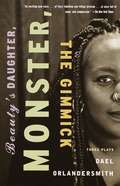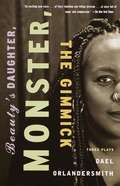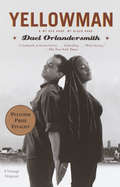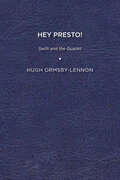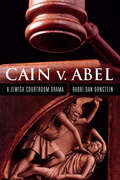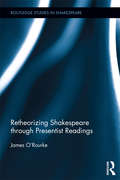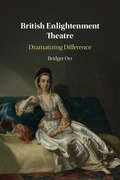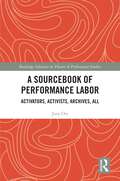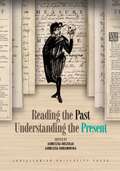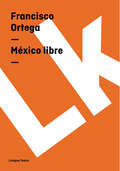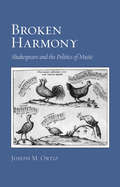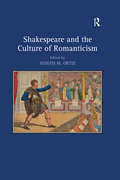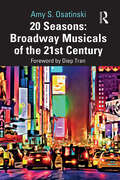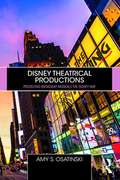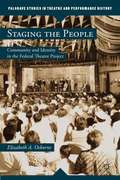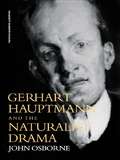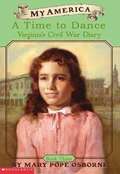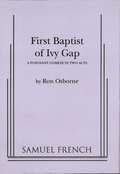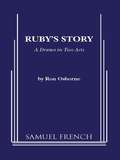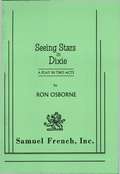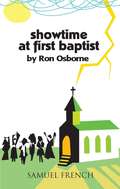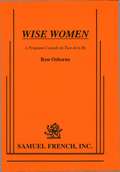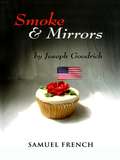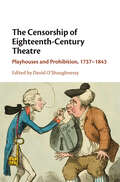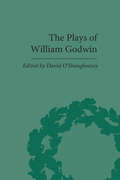- Table View
- List View
Beauty's Daughter, Monster, The Gimmick: Three Plays (Vintage Original)
by Dael OrlandersmithThe sheer exuberance of language that pours forth in Dael Orlandersmith's plays has dazzled critics and audiences alike. In these three pieces, the award-winning writer and performer celebrates the power of words to rescue the young black women she portrays from their constricted worlds. In the Obie Award-winning play "Beauty's Daughter," Diane yearns to free herself from her soul-deadening surroundings, where people drown their unfulfilled aspirations in drugs and alcohol. In "Monster," Theresa imagines a life in the rock-'n'-roll poetry bohemia of Manhattan's Lower East Side and away from her home in East Harlem, where she is scorned as a misfit. And in "The Gimmick," Alexis escapes her brutal reality among the library bookshelves, where she dreams of becoming a writer in Paris. Charged with fearless wisdom, these three electrifying plays transform rage-filled ghetto experience into a triumph of rhapsodic expression.
Beauty's Daughter, Monster, The Gimmick
by Dael OrlandersmithThree powerful plays by the famous Afro-American playwright
Yellowman
by Dael OrlandersmithThese two raucously acclaimed new plays by Dael Orlandersmith, whom The New York Times has called "an otherworldly messenger, perhaps the sorcerer's apprentice, or a heaven-sent angel with the devil in her," confirm her reputation as one of the truly unique voices in contemporary American drama.In Yellowman, a finalist for the 2002 Pulitzer Prize in Drama, Alma and Eugene have known each other since they were young children. As their friendship blossoms into love, Alma struggles to free herself from her mother's poverty and alcoholism, while Eugene must contend with the legacy of being "yellow"--lighter-skinned than his brutal and unforgiving father. In My Red Hand, My Black Hand, a young woman explores her heritage as the child of a blues-loving Native American man and a black sharecropper's daughter from Virginia. Alternately joyous and harrowing, both plays are powerful examinations of the racial tensions that fracture communities and individual lives.From the Trade Paperback edition.
Hey Presto!: Swift and the Quacks
by Hugh Ormsby-LennonIn this book the author reveals how medicine shows, both ancient and modern, galvanized Jonathan Swift’s imagination and inspired his wittiest satiric voices. Swift dubbed these multifaceted traveling entertainments his Stage-itinerant or “Mountebank’s Stage.” In the course of arguing that the stage-itinerant formed an irresistible model for A Tale of a Tub, Ormsby-Lennon also surmises that the mountebank’s stage will disclose that missing link, long sought, which connects the twin objects of Swift’s ire: gross corruptions in both religion and learning. In the early modern medicine show, the quack doctor delivered a loquacious harangue, infused with magico-mysticism and pseudoscience, high-astounding promises, and boastful narcissism. To help him sell his panaceas and snake-oil, he employed a Merry Andrew and a motley troupe of performers. From their stages, many quacks also peddled their own books, almanacs, and other ephemera, providing Grub Street with many of its best-sellers. Hacks practiced, quite literally, as quacks. Merry Andrew and mountebank traded costumes, whiskers, and voices. Swift apes them all in the Tale. Published by University of Delaware Press. Distributed worldwide by Rutgers University Press.
Cain v. Abel: A Jewish Courtroom Drama
by Rabbi Dan OrnsteinEnter the packed courtroom and take your seat as a juror on the Cain v. Abel trial. Soon, the prosecution and defense attorneys (angels from Jewish legend) will call Cain, Abel, Sin, Adam, Eve, and God to the witness stand to present their perspectives on the world&’s first murder. Great Jewish commentators throughout the ages will also offer contradictory testimony on Cain&’s emotional, societal, and spiritual influences. As jurors, when we mete out Cain&’s punishment, must we factor in his family history, psychological makeup, and the human impulse to sin? In this highly eclectic and gripping compilation of insights by Jewish commentators on the Cain and Abel story, courtroom scenes are juxtaposed with the author&’s commentary, advancing novel insights and introspection. As each of us grapples with Cain&’s actions, we confront our own darkest traits. If Cain is a symbol for all humanity, what can we do to avoid becoming like him? Furthering this conversation, Rabbi Dan Ornstein includes a discussion and activity guide to promote open dialogue about human brokenness and healing, personal impulses, and societal responsibility.
Retheorizing Shakespeare through Presentist Readings (Routledge Studies in Shakespeare)
by James O'RourkeThis book offers a theoretical rationale for the emerging presentist movement in Shakespeare studies and goes on to show, in a series of close readings, that a presentist Shakespeare is not an anachronism. Relying on a Brechtian aesthetic of "naïve surrealism" as the performative model of the early modern, urban, public theater, James O’Rourke demonstrates how this Brechtian model is able to capture the full range of interplays that could take place between Shakespeare’s words, the nonillusionist performance devices of the early modern stage, and the live audiences that shared the physical space of the theatre with Shakespeare’s actors. O’Rourke argues that the limitations placed upon the critical energies of early modern drama by the influential new historicist paradigm of contained subversion is based on a poetics of the sublime, which misrepresents the performative aesthetic of the theater as a self-sufficient spectacle that compels reception in its own terms. Reimagining Shakespeare as our contemporary, O’Rourke shows how the immanent critical logic of Shakespeare’s works can enter into dialogue with our most sophisticated critiques of our cultural fictions.
British Enlightenment Theatre: Dramatizing Difference
by Bridget OrrIn this ground-breaking work, Bridget Orr shows that popular eighteenth-century theatre was about much more than fashion, manners and party politics. Using the theatre as a means of circulating and publicizing radical Enlightenment ideas, many plays made passionate arguments for religious and cultural toleration, and voiced protests against imperial invasion and forced conversion of indigenous peoples by colonial Europeans. Irish and labouring-class dramatists wrote plays, often set in the countryside, attacking social and political hierarchy in Britain itself. Another crucial but as yet unexplored aspect of early eighteenth-century theatre is its connection to freemasonry. Freemasons were pervasive as actors, managers, prompters, scene-painters, dancers and musicians, with their own lodges, benefit performances and particular audiences. In addition to promoting the Enlightened agenda of toleration and cosmopolitanism, freemason dramatists invented the new genre of domestic tragedy, a genre that criticized the effects of commercial and colonial capitalism.
A Sourcebook of Performance Labor: Activators, Activists, Archives, All (Routledge Advances in Theatre & Performance Studies)
by Joey OrrA Sourcebook of Performance Labor presents the views and experiences of collaborators in other artists’ works. This book reorients well-known works of contemporary performance and social practice around the workers who have shaped, enacted, and supported them. It emerges from perspectives on maintenance, care, affective labor, and the knowledges created and preserved through gesture and intersubjectivity. This compilation of interviews is filled with the voices of collaborators in notable works attributed to established contemporary artists, including Francis Alÿs, Tania Bruguera, Suzanne Lacy, Ernesto Pujol, Asad Raza, Dread Scott, and Tino Sehgal. In the spirit of the artworks under discussion, this book reinvests in the possibilities for art as a collective effort to explore new ways of finding ourselves in others and others in ourselves. The Sourcebook collection is a contribution for further theorizing a largely unaddressed perspective in contemporary art. This collection will be of great interest to students and scholars in performance studies and art history.
Reading the Past, Understanding the Present
by Agnieszka Orszulak Agnieszka RomanowskaReading the Past, Understanding the Present is a collection of essays written by students from nine European universities, who took part in the Strategic Partnership, “Facing Europe in Crisis: Shakespeare’s World and Present Challenges,” aiming to promote historical understanding of the crises plaguing the contemporary Europe and the world. In each chapter, the authors examine early modern theatre, the works by William Shakespeare in particular, and how it interacts with various local and global issues, reflecting on their cultural and socio-political origins and consequences. This book offers an innovative insight into the relationship between the past represented in such plays as The Merchant of Venice, King Lear, The Tempest</i, or the history plays and the complex contemporary European context – migrant crisis, racial diversity, democracy, or the Covid-19 pandemic.
México libre
by Francisco Ortega19th century Mexico is marked by the War of Independence, the US invasion the French intervention, and reforms. In this period a pattern emerged between Mexican writers' style and political leanings, as Liberals wrote romantic prose and Conservatives displayed more neoclassical stylings. Ortega belonged to the Liberal Romantics.
Broken Harmony: Shakespeare and the Politics of Music
by Joseph M. OrtizMusic was a subject of considerable debate during the Renaissance. The notion that music could be interpreted in a meaningful way clashed regularly with evidence that music was in fact profoundly promiscuous in its application and effects. Subsequently, much writing in the period reflects a desire to ward off music’s illegibility rather than come to terms with its actual effects. In Broken Harmony Joseph M. Ortiz revises our understanding of music’s relationship to language in Renaissance England. In the process he shows the degree to which discussions of music were ideologically and politically charged. Offering a historically nuanced account of the early modern debate over music, along with close readings of several of Shakespeare’s plays (including Titus Andronicus, The Merchant of Venice, The Tempest, and The Winter’s Tale) and Milton’s A Maske, Ortiz challenges the consensus that music’s affinity with poetry was widely accepted, or even desired, by Renaissance poets. Shakespeare more than any other early modern poet exposed the fault lines in the debate about music’s function in art, repeatedly staging disruptive scenes of music that expose an underlying struggle between textual and sensuous authorities. Such musical interventions in textual experiences highlight the significance of sound as an aesthetic and sensory experience independent of any narrative function.
Shakespeare and the Culture of Romanticism
by Joseph M. OrtizThe idea of Shakespearean genius and sublimity is usually understood to be a product of the Romantic period, promulgated by poets such as Coleridge and Byron who promoted Shakespeare as the supreme example of literary genius and creative imagination. However, the picture looks very different when viewed from the perspective of the myriad theater directors, actors, poets, political philosophers, gallery owners, and other professionals in the nineteenth century who turned to Shakespeare to advance their own political, artistic, or commercial interests. Often, as in John Kemble’s staging of The Winter’s Tale at Drury Lane or John Boydell’s marketing of paintings in his Shakespeare Gallery, Shakespeare provided a literal platform on which both artists and entrepreneurs could strive to influence cultural tastes and points of view. At other times, Romantic writers found in Shakespeare’s works a set of rhetorical and theatrical tools through which to form their own public personae, both poetic and political. Women writers in particular often adapted Shakespeare to express their own political and social concerns. Taken together, all of these critical and aesthetic responses attest to the remarkable malleability of the Shakespearean corpus in the Romantic period. As the contributors show, Romantic writers of all persuasions”Whig and Tory, male and female, intellectual and commercial”found in Shakespeare a powerful medium through which to claim authority for their particular interests.
20 Seasons: Broadway Musicals of the 21st Century
by Amy S. Osatinski20 Seasons: Broadway Musicals of the 21st Century catalogues, categorizes, and analyzes the 269 musicals that opened on Broadway from the 2000-2001 season through the 2019-2020 season. This book is the first to comprehensively examine the musicals that premiered on Broadway during this important historical period, which was bookended by the 9/11 terrorist attacks on one end and the Coronavirus pandemic on the other. It begins by exploring the historical context for the first 20 years of the 21st century and how this impacted American culture and theatre. Rather than chronologically, the musicals are then organized into categories based on their source material and whether they were original musicals or revivals, painting a detailed picture of the Broadway musical in first 20 years of the 21st century. Jukebox musicals, screen-to-stage musicals, revivals, and other original musicals are all covered, and each chapter ends with reading guides and discussion prompts. The book not only discusses what was produced, but by whom, uncovering the stark lack of representation for women and artists of color on Broadway musical creative and design teams. Additionally, the last chapter discusses the COVID-19 pandemic, the Broadway shutdown, and what happened to the Broadway musical during the shutdown, including the response to the Black Lives Matter movement in the summer of 2020. 20 Seasons: Broadway Musicals of the 21st Century will appeal to fans and scholars of musical theatre, as well as students of Musical Theatre, Musical Theatre History, American Studies, and Pop Culture Studies.
Disney Theatrical Productions: Producing Broadway Musicals the Disney Way
by Amy S. OsatinskiDisney Theatrical Productions: Producing Broadway Musicals the Disney Way is the first work of scholarship to comprehensively examine the history and production practices of Disney Theatrical Productions (DTP), the theatrical producing arm of the studio branch of the Walt Disney Corporation. This book uncovers how DTP has forged a new model for producing large-scale musicals on Broadway by functioning as an independent theatrical producer under the umbrella of a large entertainment corporation. Case studies of three productions (The Lion King, Tarzan, and Newsies) demonstrate the flexibility and ingenuity of DTP, and showcase the various production models that the company has employed over the years. Exploring topics such as the history of DTP, its impact on the revitalization of Times Square, and its ability to open up a new audience base for Broadway theatre, this volume examines the impact that DTP has had on American musicals, both domestically and internationally, and how its accomplishments have helped reshape the Broadway landscape. This book is relevant to students in Musical Theatre, History of Musical Theatre, Theatre History, and Arts Management courses, along with general Disney enthusiasts.
Staging the People
by Elizabeth A. OsborneThe Federal Theatre Project stands alone as the only national theatre in the history of the United States. This study re-imagines this vital moment in American history, considering the Federal Theatre Project on its own terms - as a "federation of theatres" designed to stimulate new audiences and create locally-relevant theatre during the turbulent 1930s. It integrates a wealth of previously undiscovered archival materials with cultural history, delving into regional activities in Chicago, Boston, Portland, Atlanta, and Birmingham, as well as tours of refugee camps and Civilian Conservation Corps Divisions. For a brief, exhilarating moment, the Federal Theatre Project created a democratic theatre that staged the American people.
Gerhard Hauptmann and the Naturalist Drama
by John OsborneWhat was German Naturalism? What were its achievements? How does it compare with its counterparts in other European countries? These are some of the difficult questions addressed by John Osborne in Gerhart Hauptmann and the Naturalist Drama, a revised and updated version of his The Naturalist Drama in Germany, now widely acknowledged as the standard introduction to the subject. The debates to which he contributed, and in some cases initiated, on Naturalism in the German theatre, Naturalist theory in Germany, and the development of the Naturalist movement to the contemporary Social Democrat movement, have remained central issues. This revised edition preserves the structure and approach of the original, including its emphasis on the early dramas of Hauptmann, while taking full account of subsequent scholarship which provides the context in which this Naturalist playwright's work can be placed.
A Time to Dance: Virginia's Civil War Diary, Book Three (My America Series)
by Mary Pope Osborne Will OsborneVirginia Dickens continues to chronicle the aftermath of the Civil War, as she and her family move their lives from Washington, D.C. to New York City. Throughout the times of difficulty and joy, Ginny is always courageous and sweet.
First Baptist of Ivy Gap
by Ron OsborneComedy / 6f / During WWII, six women gather at the church to roll bandages and plan the church's 75th anniversary. Overseeing things is Edith, the pastor's wise-cracking wife who dispenses Red Cross smocks and witty repartee to Luby, whose son is fighting in the Pacific; Mae Ellen, the church's rebellious organist who wants to quit but hasn't the courage; Olene, who dreams of a career in Hollywood; Sammy, a shy newcomer with a secret; and Vera, an influential Baptist with a secret of her own. When Luby learns her son has been wounded, she confounds the others by blaming the vulnerable Sammy. Twenty-five years later, our "First Baptist Six" reunite. Back to reconcile with Luby - whose son died of his wounds - is Sammy, whose own son is now in Vietnam; and Olene, whose flashy show business career will set the town on its ear. There to welcome them are Vera, her secret still safe; Mae Ellen, still rebellious and still looking for an escape; and Edith, whose biggest challenge isn't the church's upcoming centennial but revelations that shake relationships formed over a quarter of a century. With humor and pathos, these six very different women find comfort, forgiveness and redemption in each other. Winner of multiple playwriting awards.
Ruby's Story
by Ron OsborneDrama / Characters: 3m, 6f / June 1944. In England, Allied troops are massing for an invasion. On a small farm in Appalachia, a different kind of war is about to rage. Here, Walter and Grace share a home with four daughters: Rose, who struggles to understand why Stan - an immigrant coal miner and the love of her life - abruptly left to join the Polish Free Forces; Helga, who fears for her husband who's in the Army and - like Stan - assigned to a combat unit in England; Frieda, the family's adventure-seeking daughter, who works in a factory making uniforms and new friends, one of whom she can't bring home; and teenage Ruby who yearns to be the next Edward R. Murrow, but who must first come to grips with a family falling apart at the seams. D-Day speeds the dissolution process. But at its core is Walter's seeming allegiance to his German heritage, no matter that Helga's husband and Rose's fiancé are at war against all things German. There - through every battle - is Grace, hoping liberal doses of humor, love and understanding can restore harmony. It is adult Ruby - back for a funeral, seeking answers to questions that haunt her - who retells the family's struggle against prejudice, fear, delusion and self-loathing.
Seeing Stars in Dixie
by Ron OsborneComedic Drama / 1m, 4f / It's 1956 and Hollywood has arrived in Natchez, Mississippi with its brightest stars to film Raintree County . Meanwhile at Clemmie's, a Natchez tea room, the widowed proprietor who has a fascination with movies and a secret admirer, oversees her own cast of characters: Tootie, her take charge friend; Jo Beth, a former beauty queen; Glease, a man more comfortable with women than macho men, and Marjorie, an unethical social climber. Competition for a small role in the movie brings out the best and worst of these memorable characters. Twists, turns and revelations lead Clemmie to trade a moment of fame for love and the chance to impact the lives of people dear to her. Originally produced at the Sonoma County Repertory Theatre in Sebastopol, CA.
Showtime at First Baptist
by Ron OsborneDramatic Comedy / 6f Showtime at First Baptist is the sequel to the hugely popular and widely produced First Baptist of Ivy Gap. First Baptist of Ivy Gap's 100th anniversary picnic was a smashing success, except for one little thing: the bolt of lightning that struck the church's steeple, igniting a fire that destroyed the sanctuary and so much more. In the wake of the disaster, key women of the church - led by Edith, the pastor's take-charge wife - gather in what's left (the fellowship hall) to commiserate and try to put things back together. To raise spirits and funds for rebuilding, the women plan an evening of entertainment designed to showcase the congregation's talent. Could it be that some of Edith's gang plan a song and dance number that may shock the congregation? If so, how will they circumvent the authority of the all-male conservative board of deacons, not to mention, one of their own? Change is in the air as these six diverse women challenge institutions as well as each other. Along the way, there are laughs to be shared, battles to be fought, love to be won, relationships to be mended, and losses to be grieved. "Good natured religious jokes aplenty and drama ... But the real meat is a gentle, warm story about six good women and how they came together despite times that are, 'a changing' ... A serious play and a delightful comedy ... I sure enjoyed it." - Bristol Herald-Courier "Sure to be an instant classic ... This touching comedy is full of laughs, realistic characters and thought-provoking issues ... The Southern women who inhabit the world of Ivy Gap are amazing! Osborne can definitely write great women characters ... It's small-town politics at its most entertaining ... Bring the whole family." - Washington County News
Wise Women
by Ron OsborneComedy / 2m, 4f / Unit set / It's almost Christmas, 1944. In Knoxville, Tennessee, a frustrated mother with a secret and a teenage daughter with a dream take in two young roomers who work at a nearby bomb-making plant. Both girls are asserting their independence, one in the company of servicemen, the other as a contestant in a Miss Bombshell U.S.A. competition, an action that puts her at odds with her father, a preacher in a small Virginia town. Along the way, the teenage daughter, who worries more about rumors of an asteroid said to be streaking toward nearby Chattanooga than a vicious war raging around the world, bamboozles her mother into allowing her to attend a Frank Sinatra concert at the local USO. When she brings home a young war-bound Marine as naive as herself, this colorful collection of characters is pulled apart, then mended with humor, romance, twists, turns and revelations. As these women struggle, grow and ultimately succeed, at least for one fragile moment in time-they remind us that we're all "family" and, in each other's company, we may find ourselves.
Smoke And Mirrors
by Will OsborneFull Length, Mystery Comedy \ 4m, 1f \ Int. \ This rivetting mystery comedy will keep audiences guessing as they go on location to an isolated island off the Gulf coast to watch power hungry producer/director Hamilton Orr lure his timid screenwriter Clark into a scheme to get rid of the insufferable star of their multi-million dollar film. The plot hinges on the rehearsal of a suicide scene and the only witness to the murder is Hamilton's wife Barbara, the film's quirky publicist and Clark's former lover. The wily, eccentric sheriff unearths one surprise after another until the final stunning revelation. \ "A good mystery ... [with] funny dialogue, well crafted characters. If Agatha Christie and Noel Coward had collaborated on Robert Altman's 'The Player', they might have come up with something like this." Palm Beach Post.
The Censorship of Eighteenth-Century Theatre: Playhouses and Prohibition, 1737–1843
by David O’ShaughnessyThis collection reveals the wide-ranging impact of the Stage Licensing Act of 1737 on literary and theatrical culture in Georgian Britain. Demonstrating the differing motivations of the state in censoring public performances of plays after the Stage Licensing Act of 1737 and until the Theatres Act 1843, chapters cover a wide variety of theatrical genres across a century and show how the mechanisms of formal censorship operated under the Lord Chamberlain's Examiner of Plays. They also explore the effects of informal censorship, whereby playwrights, audiences and managers internalized the censorship regime. As such, the volume moves beyond a narrow focus on erasures and emendations visible on manuscripts to elucidate censorship's wide-ranging significance across the long eighteenth century. Demonstrating theatre archives' potency as a resource for historical research, this volume is of exceptional value for researchers interested in the evolving complexities of Georgian society, its politics and mores.
The Plays of William Godwin (The Pickering Masters)
by David O'ShaughnessyBest known for "Enquiry Concerning Political Justice" (1793) and "Caleb Williams" (1794), William Godwin (1756-1836) is one of the most important figures of the Romantic period. This book offers academics the chance to build a complete picture of Godwin as a writer and political figure.
